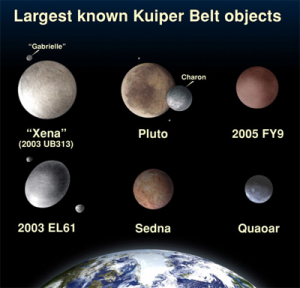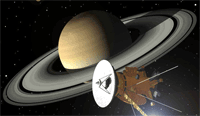Discovered in the 1930, Pluto was considered the smallest and the ninth planet from the sun in our solar system. It was the outer most planet in the solar system. However, on 24 August, 2006, the International Astronomical Union (IAU), an organization of professional astronomers decided that Pluto was not an actual planet, by definition, due to its size and location in space. They passed two resolutions, one explaining the characteristic of a planet and another classifying or rather re-classifying Pluto. Pluto is now classified as a dwarf planet. A dwarf planet is a planet like object that orbits the sun, has enough mass that its shape is influenced by gravitational forces than mechanical ones but is small that it cannot clear its neighborhood. Pluto shares more features with comet than a planet.
Pluto is more than 3.6 billion miles from the sun, which is 40 times farther from sun than earth. Pluto is found in the region of space called Kuiper Belt and is the largest object in it. The Kuiper Belt is a shadowy disk-like zone present beyond the planet Neptune and is residence to thousands of small icy objects similar to Pluto. These icy objects are similar to Pluto in terms of size and composition. Pluto is smaller in size than the Earth’s moon, being 1,400 miles in width. Pluto takes about 248 years to revolve completely around the sun and one day at Pluto is approximately 6.5 days on Earth. Pluto has five moons, Charon, Nix, Hydra, Kerberos and Styx.
If Pluto is not a planet, the question arises that why is it not a planet anymore. In 2003, a new object was noticed beyond Pluto by an astronomer. Initially, it was considered to be a planet. The size of the new object was estimated to be larger than Pluto. It was named Eris (EER-is). The discovery of Eris stirred up a debate on the criteria that defines a planet and whether Pluto should be called a planet. The size and location of Pluto did not qualify it as a planet and hence it was termed as dwarf planet. Pluto is also referred to as a plutoid. A plutoid is defined as a dwarf planet which is further away from the planet Neptune in our solar system. Apart from Pluto, the other two known plutoid are Eris and Makemake (MAH-kee-MAH-kee).
The factors which contributed to revoking of Pluto status as a planet include: its small size, which is smaller than Earth’s moon; its dense and rocky surface which is dissimilar to its neighboring gaseous Jovian planets ‘“ Jupiter, Saturn, Uranus and Neptune; its erratic orbit which orbits sun at a 17 degree angle, unlike all the other planets in the solar system which orbits in a flat plane; its largest moon is half the size of Pluto.
The main reason for Pluto losing its status was not any changes in its composition or description. Nothing about Pluto changed; rather the definition of planet was redefined. Once the resolution was passed redefining the criteria for a planet, Pluto no longer remained a planet. According to the resolution, a celestial body is a planet when it is round in shape, orbits the sun and can clear its neighborhood. Pluto fulfill two of the criteria that is it is round in shape and orbits around the sun, but it failed the third criteria that is it cannot clear its neighborhood like the other eight planets.
What does clear its neighborhood implies? As planets are formed, they become the central gravitational body in the orbit in which they circle the sun. On their pathway, when they come across other objects usually smaller, they act in two ways. They consume the smaller objects or they push them away with their gravitational force. In their orbits, there are no objects of comparable size other than its own satellites and objects under their gravitational pull. Pluto has the mass only 0.07 times the mass of the objects it encounters in its orbit. Hence, it is unable to clear its neighborhood and does not fulfill the third criteria for a planet.
As aforementioned, objects failing the third criteria are called a dwarf planet. There are a large number of objects with size and mass same as the Pluto orbiting in Pluto’s orbit. And until Pluto collide with them and gain mass, it will remain a dwarf planet.
Although Pluto is a dwarf planet, it still captivates astronomers. The fascinating icy planet has motivated NASA to send a New Horizons spacecraft to visit it. The New Horizons is estimated to reach Pluto in July 2015 and it will be capturing the first close up images of the Pluto’s surface. It will be the first time scientists will be able to study the planet. Irrespective of its status, Pluto remains the object of study and fascination.
Reference:
NASA, 2012, What Is Pluto? Retrieved from: http://www.nasa.gov/audience/forstudents/k-4/stories/what-is-pluto-k4.html#.VJXdal4D7A
Fraser Cain, 2012, Why Pluto is No Longer a Planet, Retrieved from: http://www.universetoday.com/13573/why-pluto-is-no-longer-a-planet/












Leave a Reply